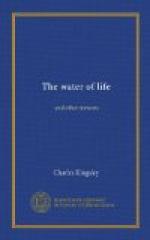Some light has been thrown, lately, on the figures of these creatures, by the sculptures of those very Assyrian cities to which Ezekiel was a captive,—those huge winged oxen and lions with human heads; and those huge human figures with four wings each, let down and folded round them just as Ezekiel describes, and with heads, sometimes of the lion, and sometimes of the eagle. None, however, have been found as yet, I believe, with four faces, like those of Ezekiel’s Vision; they are all of the simpler form of Solomon’s cherubim. But there is little doubt that these sculptures were standing there perfect in Ezekiel’s time, and that he and the Jews who were captive with him may have seen them often. And there is little doubt also what these figures meant: that they were symbolic of royal spirits—those thrones, dominations, princedoms, powers, of which Milton speaks,—the powers of the earth and heaven, the royal archangels who, as the Chaldaeans believed, governed the world, and gave it and all things life; symbolized by them under the types of the four royal creatures of the world, according to the Eastern nations; the ox signifying labour, the lion power, the eagle foresight, and the man reason.
So with the wheels which Ezekiel sees. We find them in the Assyrian sculptures—wheels with a living spirit sitting in each, a human figure with outspread wings; and these seem to have been the genii, or guardian angels, who watched over their kings, and gave them fortune and victory.
For these Chaldaeans were specially worshippers of angels and spirits; and they taught the Jews many notions about angels and spirits, which they brought home with them into Judaea after the captivity.
Of them, of course, we read little or nothing in Holy Scripture; but there is much, and too much, about them in the writings of the old Rabbis, the Scribes and Pharisees of the New Testament.
Now Ezekiel, inspired by the Spirit of God, rises far above the old Chaldaeans and their dreams. Perhaps the captive Jews were tempted to worship these cherubim and genii, as the Chaldaeans did; and it may be that Ezekiel was commissioned by God to set them right, and by his vision to give a type, pattern, or picture of God’s spiritual laws, by which He rules the world.
Be that as it may. In the first place, Ezekiel’s cherubim are far more wonderful and complicated than those which he would see on the walls of the Assyrian buildings. And rightly so; for this world is far more wonderful, more complicated, more cunningly made and ruled, than any of man’s fancies about it; as it is written in the Book of Job,—’Where wast thou when I laid the foundations of the earth? declare, if thou hast understanding. Whereupon are the foundations thereof fastened? or who laid the corner-stone thereof; when the morning stars sang together, and all the sons of God shouted for joy?’




